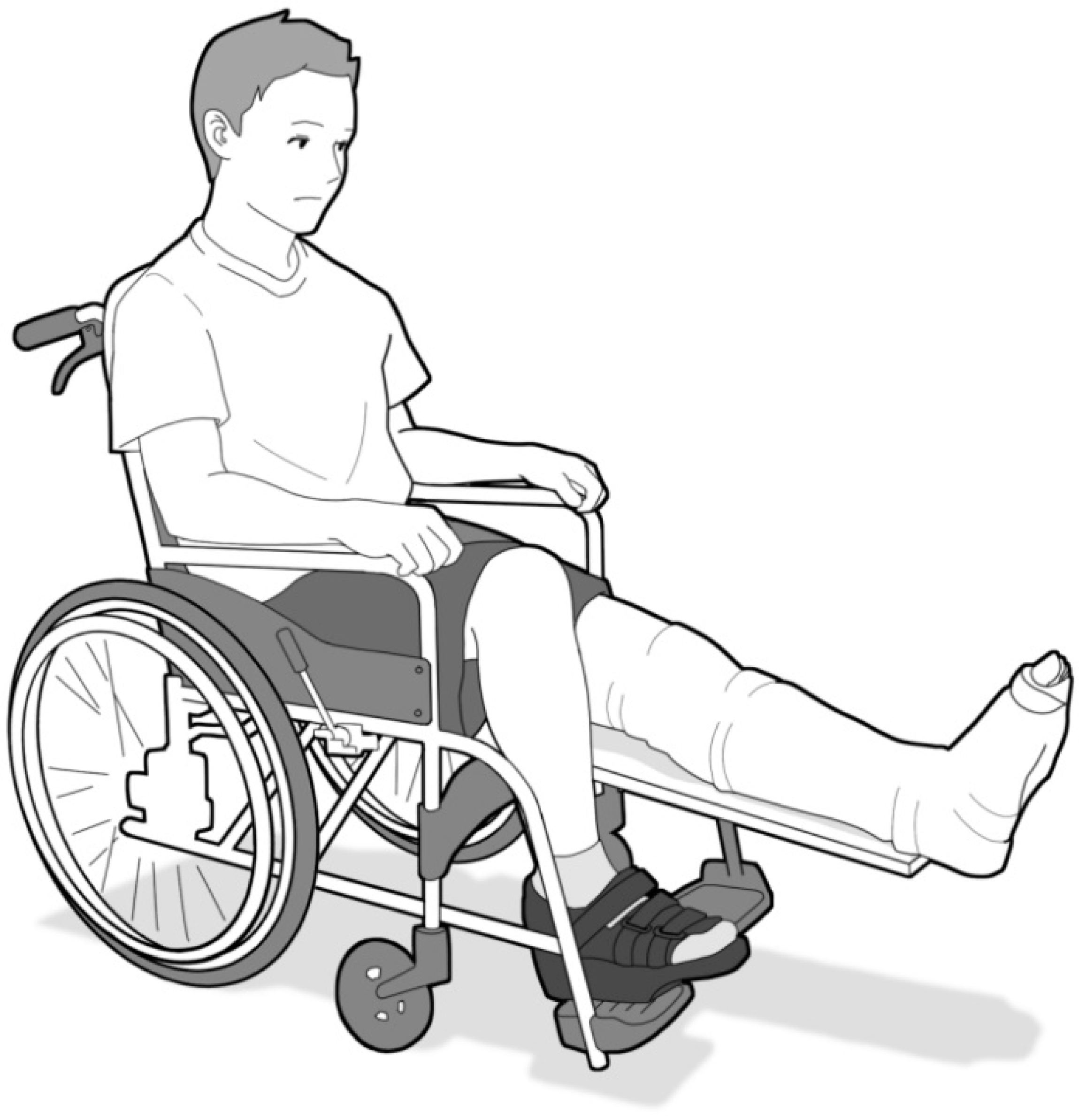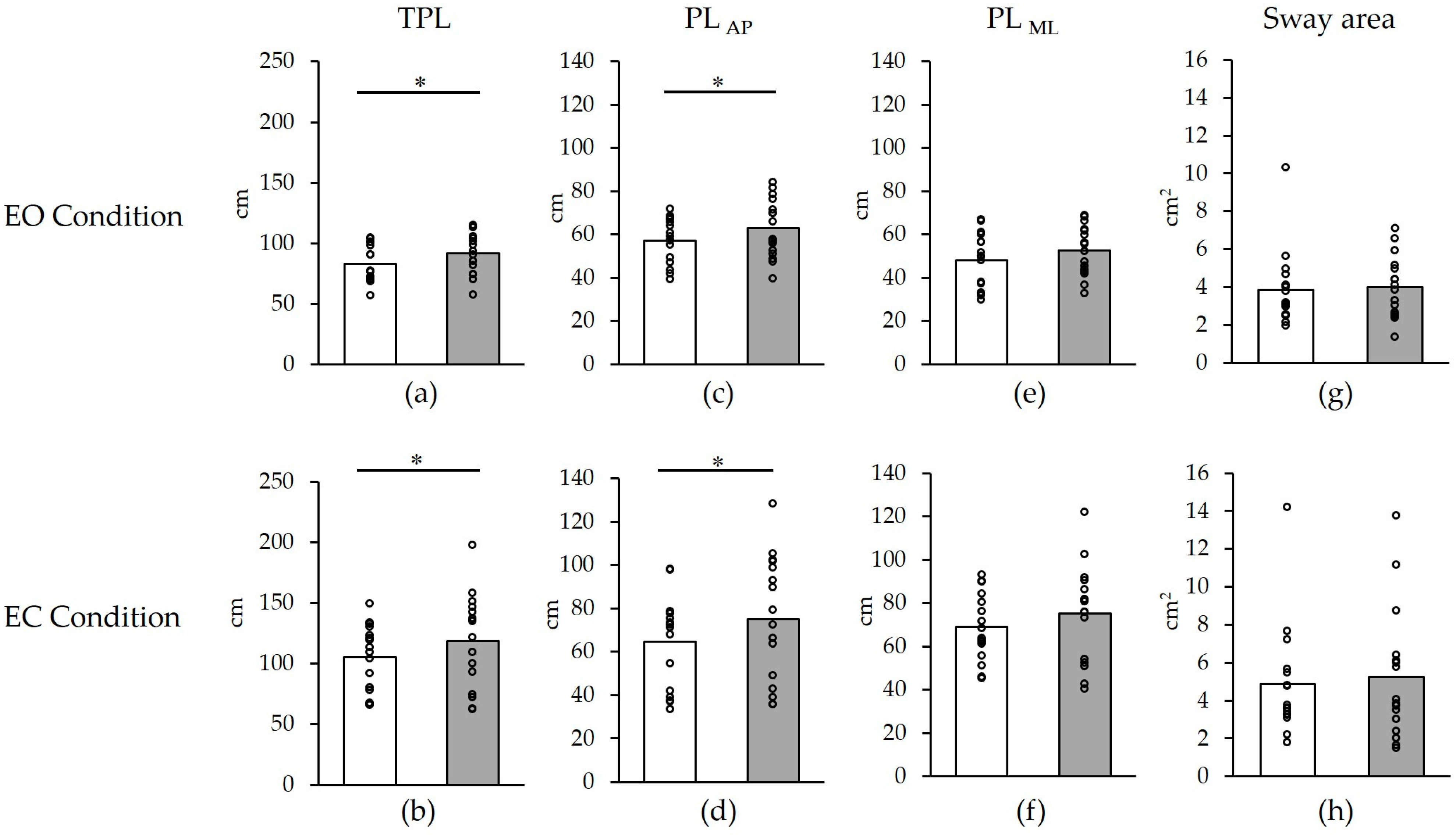Short-Term Cast Immobilization of a Unilateral Lower Extremity and Physical Inactivity Induce Postural Instability during Standing in Healthy Young Men
Abstract
:1. Introduction
2. Materials and Methods
2.1. Participants
2.2. Movement Restriction and Physical Inactivity
2.3. Examination of Standing Postural Stability
2.4. Statistical Analysis
3. Results
4. Discussion
5. Conclusions
Author Contributions
Funding
Institutional Review Board Statement
Informed Consent Statement
Data Availability Statement
Acknowledgments
Conflicts of Interest
References
- Horak, F.B. Postural orientation and equilibrium: What do we need to know about neural control of balance to prevent falls? Age Ageing 2006, 35, ii7–ii11. [Google Scholar] [CrossRef] [PubMed]
- Peterka, R.J. Sensory integration for human balance control. Handb. Clin. Neurol. 2018, 159, 27–42. [Google Scholar] [CrossRef] [PubMed]
- Ivanenko, Y.; Gurfinkel, V.S. Human postural control. Front. Neurosci. 2018, 12, 171. [Google Scholar] [CrossRef] [PubMed]
- Osoba, M.Y.; Rao, A.K.; Agrawal, S.K.; Lalwani, A.K. Balance and gait in the elderly: A contemporary review. Laryngoscope Investig. Otolaryngol. 2019, 4, 143–153. [Google Scholar] [CrossRef]
- Khan, M.A.; Moiz, J.A.; Raza, S.; Verma, S.; Shareef, M.Y.; Anwer, S.; Alghadir, A. Physical and balance performance following exercise induced muscle damage in male soccer players. J. Phys. Ther. Sci. 2016, 28, 2942–2949. [Google Scholar] [CrossRef] [PubMed]
- Sahoo, P.K.; Sahu, M.M. Quantitative assessment of postural balance in patients with chronic anterior cruciate ligament injury—A controlled study. J. Clin. Orthop. Trauma 2021, 23, 101645. [Google Scholar] [CrossRef]
- Kim, A.Y.; Lee, J.K.; Kim, S.H.; Choi, J.; Song, J.J.; Chae, S.W. Is postural dysfunction related to sarcopenia? A population-based study. PLoS ONE 2020, 15, e0232135. [Google Scholar] [CrossRef]
- Saumur, T.M.; Gregor, S.; Mochizuki, G.; Mansfield, A.; Mathur, S. The effect of bed rest on balance control in healthy adults: A systematic scoping review. J. Musculoskelet. Neuronal Interact. 2020, 20, 101–113. [Google Scholar]
- Boyd, A.S.; Benjamin, H.J.; Asplund, C. Splints and casts: Indications and methods. Am. Fam. Physician 2009, 80, 491–499. [Google Scholar]
- Caplan, N.; Forbes, A.; Radha, S.; Stewart, S.; Ewen, A.; St Clair Gibson, A.; Kader, D. Effects of 1 week of unilateral ankle immobilization on plantar-flexor strength, balance, and walking speed: A pilot study in asymptomatic volunteers. J. Sport Rehabil. 2015, 24, 156–162. [Google Scholar] [CrossRef]
- Elam, C.; Hvid, L.G.; Christensen, U.; Kjær, M.; Magnusson, S.P.; Aagaard, P.; Bunketorp Käll, L.; Suetta, C. Effects of age on muscle power, postural control and functional capacity after short-term immobilization and retraining. J. Musculoskelet. Neuronal Interact. 2022, 22, 486–497. [Google Scholar]
- Salas-Gómez, D.; Fernández-Gorgojo, M.; Sánchez-Juan, P.; Pérez-Núñez, M.I.; Laguna-Bercero, E.; Prat-Luri, A.; Barbado, D. Measuring recovery and understanding long-term deficits in balance, ankle mobility and hip strength in people after an open reduction and internal fixation of bimalleolar fracture and their impact on functionality: A 12-month longitudinal study. J. Clin. Med. 2022, 11, 2539. [Google Scholar] [CrossRef]
- Ikeda, T.; Takano, M.; Oka, S.; Suzuki, A.; Matsuda, K. Changes in postural sway during upright stance after short-term lower limb physical inactivity: A prospective study. PLoS ONE 2022, 17, e0272969. [Google Scholar] [CrossRef] [PubMed]
- Huber, R.; Ghilardi, M.F.; Massimini, M.; Ferrarelli, F.; Riedner, B.A.; Peterson, M.J.; Tononi, G. Arm immobilization causes cortical plastic changes and locally decreases sleep slow wave activity. Nat. Neurosci. 2006, 9, 1169–1176. [Google Scholar] [CrossRef]
- Marchese, S.M.; Farinelli, V.; Bolzoni, F.; Esposti, R.; Cavallari, P. Overview of the cerebellar function in anticipatory postural adjustments and of the compensatory mechanisms developing in neural dysfunctions. Appl. Sci. 2020, 10, 5088. [Google Scholar] [CrossRef]
- Penedo, T.; Polastri, P.F.; Rodrigues, S.T.; Santinelli, F.B.; Costa, E.C.; Imaizumi, L.; Barbieri, R.A.; Barbieri, F.A. Motor strategy during postural control is not muscle fatigue joint-dependent, but muscle fatigue increases postural asymmetry. PLoS ONE 2021, 16, e0247395. [Google Scholar] [CrossRef]
- Yim, J.; Petrofsky, J.; Lee, H. Correlation between mechanical properties of the ankle muscles and postural sway during the menstrual cycle. Tohoku J. Exp. Med. 2018, 244, 201–207. [Google Scholar] [CrossRef] [PubMed]
- van Melick, N.; Meddeler, B.M.; Hoogeboom, T.J.; Nijhuis-van der Sanden, M.W.G.; van Cingel, R.E.H. How to determine leg dominance: The agreement between self-reported and observed performance in healthy adults. PLoS ONE 2017, 12, e0189876. [Google Scholar] [CrossRef]
- Rhea, C.K.; Kiefer, A.W.; Wright, W.G.; Raisbeck, L.D.; Haran, F.J. Interpretation of postural control may change due to data processing techniques. Gait Posture 2015, 41, 731–735. [Google Scholar] [CrossRef]
- Chen, B.; Liu, P.; Xiao, F.; Liu, Z.; Wang, Y. Review of the upright balance assessment based on the force plate. Int. J. Environ. Res. Public Health 2021, 18, 2696. [Google Scholar] [CrossRef]
- Lakens, D. Calculating and reporting effect sizes to facilitate cumulative science: A practical primer for t-tests and ANOVAs. Front. Psychol. 2013, 4, 863. [Google Scholar] [CrossRef]
- Okamoto, Y.; Ishii, D.; Yamamoto, S.; Ishibashi, K.; Kohno, Y.; Numata, K. Effects of short-term upper limb immobilization on sensory information processing and corticospinal excitability. Exp. Brain Res. 2022, 240, 1979–1989. [Google Scholar] [CrossRef] [PubMed]
- Tokuno, C.D.; Taube, W.; Cresswell, A.G. An enhanced level of motor cortical excitability during the control of human standing. Acta Physiol. 2009, 195, 385–395. [Google Scholar] [CrossRef] [PubMed]
- Palazzo, F.; Nardi, A.; Lamouchideli, N.; Caronti, A.; Alashram, A.; Padua, E.; Annino, G. The effect of age, sex and a firm-textured surface on postural control. Exp. Brain Res. 2021, 239, 2181–2191. [Google Scholar] [CrossRef]
- Ikeda, T.; Oka, S.; Shibuya, T.; Matsuda, K.; Suzuki, A. Effects of short-term immobilization of the upper limb on the somatosensory pathway: A study of short-latency somatosensory evoked potentials. J. Phys. Ther. Sci. 2019, 31, 603–607. [Google Scholar] [CrossRef] [PubMed]
- Scotto, C.R.; Meugnot, A.; Casiez, G.; Toussaint, L. Short-term sensorimotor deprivation impacts feedforward and feedback processes of motor control. Front. Neurosci. 2020, 14, 696. [Google Scholar] [CrossRef] [PubMed]
- Halanski, M.; Noonan, K.J. Cast and splint immobilization: Complications. J. Am. Acad Orthop. Surg. 2008, 16, 30–40. [Google Scholar] [CrossRef] [PubMed]
- Hof, A.L.; Gazendam, M.G.J.; Sinke, W.E. The condition for dynamic stability. J. Biomech. 2005, 38, 1–8. [Google Scholar] [CrossRef]
- Ku, P.X.; Abu Osman, N.A.; Wan Abas, W.A. Balance control in lower extremity amputees during quiet standing: A systematic review. Gait Posture 2014, 39, 672–682. [Google Scholar] [CrossRef]
- Picorelli, A.M.A.; Hatton, A.L.; Gane, E.M.; Smith, M.D. Balance performance in older adults with hip osteoarthritis: A systematic review. Gait Posture 2018, 65, 89–99. [Google Scholar] [CrossRef]
- Shiozawa, S.; Hirata, R.P.; Graven-Nielsen, T. Center of pressure displacement of standing posture during rapid movements is reorganised due to experimental lower extremity muscle pain. PLoS ONE 2015, 10, e0144933. [Google Scholar] [CrossRef] [PubMed]
- Anker, L.C.; Weerdesteyn, V.; van Nes, I.J.W.; Nienhuis, B.; Straatman, H.; Geurts, A.C.H. The relation between postural stability and weight distribution in healthy subjects. Gait Posture 2008, 27, 471–477. [Google Scholar] [CrossRef] [PubMed]
- Ioannidis, J.P.A. Why most published research findings are false. PLoS Med. 2005, 2, e124. [Google Scholar] [CrossRef]
- Halpern, A.I.; Jansen, J.A.F.; Giladi, N.; Mirelman, A.; Hausdorff, J.M. Does time of day influence postural control and gait? A review of the literature. Gait Posture 2021, 92, 153–166. [Google Scholar] [CrossRef] [PubMed]
- Korchi, K.; Noé, F.; Bru, N.; Monce, M.; Cabianca-Martin, O.; Paillard, T. Influence of plantar cutaneous sensitivity on daily fluctuations of postural control and gait in institutionalized older adults: A hierarchical cluster analysis. Chronobiol. Int. 2019, 36, 870–882. [Google Scholar] [CrossRef]



| Before | After 10 h | p-Values | d-Values | ||
|---|---|---|---|---|---|
| EO | TPL (cm) | 83.2 ± 14.8 | 91.6 ± 16.5 | 0.04 | 0.54 |
| PLAP (cm) | 48.1 ± 12.3 | 52.6 ± 11.0 | 0.01 | 0.39 | |
| PLML (cm) | 57.2 ± 10.0 | 62.9 ± 13.1 | 0.06 | 0.50 | |
| Sway area (cm2) | 3.8 ± 2.0 | 4.0 ± 1.6 | 0.69 | 0.10 | |
| EC | TPL (cm) | 105.4 ± 26.2 | 118.7 ± 37.5 | 0.04 | 0.41 |
| PLAP (cm) | 64.6 ± 20.6 | 75.2 ± 28.1 | 0.03 | 0.43 | |
| PLML (cm) | 68.9 ± 15.1 | 75.1 ± 21.6 | 0.10 | 0.34 | |
| Sway area (cm2) | 4.9 ± 2.9 | 5.2 ± 3.4 | 0.51 | 0.12 | |
| Before | After 10 h | p-Values | d-Values | ||
|---|---|---|---|---|---|
| EO | Mean COP displacementAP (cm) | −8.2 ± 2.0 | −8.2 ± 1.7 | 0.98 | 0.01 |
| Mean COP displacementML (cm) | 0.4 ± 0.4 | 1.0 ± 1.1 | 0.04 | 0.72 | |
| EC | Mean COP displacementAP (cm) | −7.8 ± 1.9 | −7.4 ± 1.7 | 0.30 | 0.25 |
| Mean COP displacementML (cm) | 0.3 ± 0.4 | 0.7 ± 0.8 | 0.03 | 0.71 | |
Disclaimer/Publisher’s Note: The statements, opinions and data contained in all publications are solely those of the individual author(s) and contributor(s) and not of MDPI and/or the editor(s). MDPI and/or the editor(s) disclaim responsibility for any injury to people or property resulting from any ideas, methods, instructions or products referred to in the content. |
© 2023 by the authors. Licensee MDPI, Basel, Switzerland. This article is an open access article distributed under the terms and conditions of the Creative Commons Attribution (CC BY) license (https://creativecommons.org/licenses/by/4.0/).
Share and Cite
Ikeda, T.; Oka, S.; Tokuhiro, J.; Suzuki, A.; Matsuda, K. Short-Term Cast Immobilization of a Unilateral Lower Extremity and Physical Inactivity Induce Postural Instability during Standing in Healthy Young Men. Healthcare 2023, 11, 2525. https://doi.org/10.3390/healthcare11182525
Ikeda T, Oka S, Tokuhiro J, Suzuki A, Matsuda K. Short-Term Cast Immobilization of a Unilateral Lower Extremity and Physical Inactivity Induce Postural Instability during Standing in Healthy Young Men. Healthcare. 2023; 11(18):2525. https://doi.org/10.3390/healthcare11182525
Chicago/Turabian StyleIkeda, Takuro, Shinichiro Oka, Junya Tokuhiro, Akari Suzuki, and Kensuke Matsuda. 2023. "Short-Term Cast Immobilization of a Unilateral Lower Extremity and Physical Inactivity Induce Postural Instability during Standing in Healthy Young Men" Healthcare 11, no. 18: 2525. https://doi.org/10.3390/healthcare11182525





